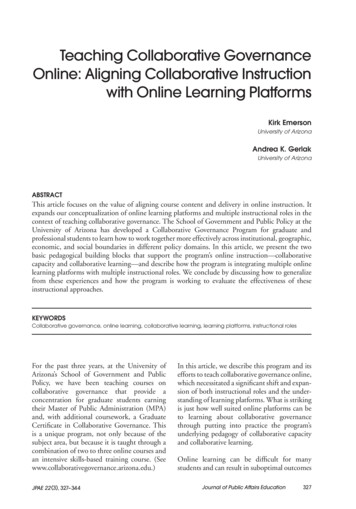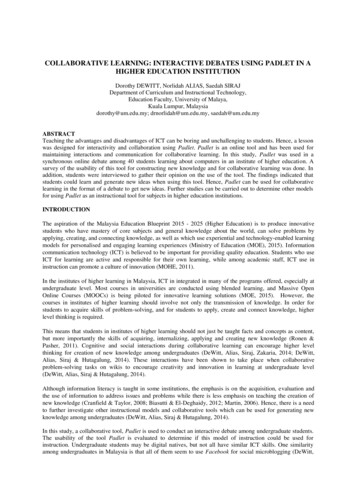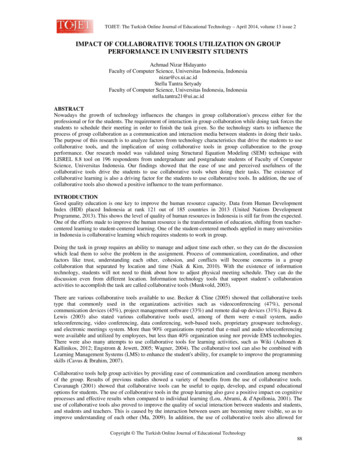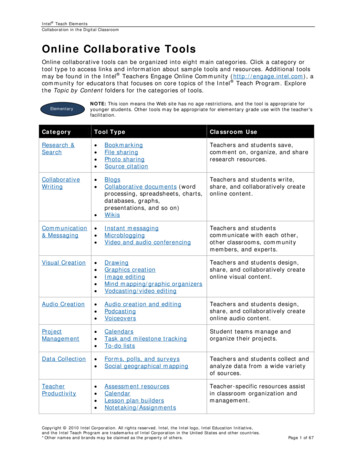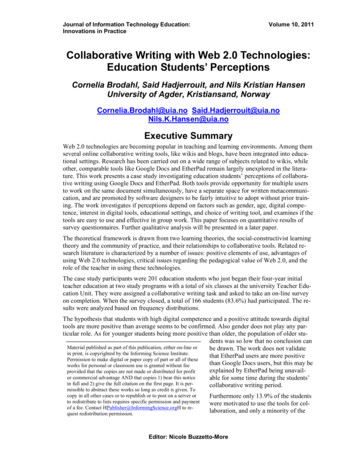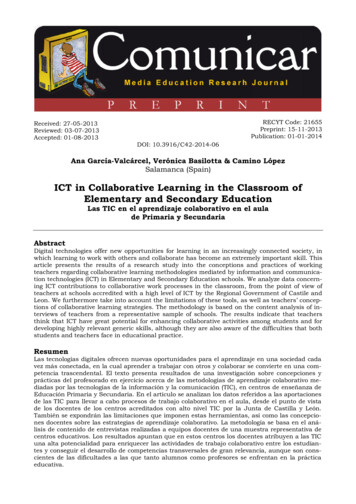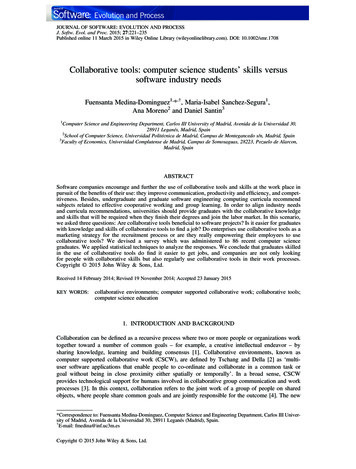
Transcription
JOURNAL OF SOFTWARE: EVOLUTION AND PROCESSJ. Softw. Evol. and Proc. 2015; 27:221–235Published online 11 March 2015 in Wiley Online Library (wileyonlinelibrary.com). DOI: 10.1002/smr.1708Collaborative tools: computer science students’ skills versussoftware industry needsFuensanta Medina-Dominguez1,*,†, Maria-Isabel Sanchez-Segura1,Ana Moreno2 and Daniel Santin31Computer Science and Engineeering Department, Carlos III University of Madrid, Avenida de la Universidad 30,28911 Leganés, Madrid, Spain2School of Computer Science, Universidad Politécnica de Madrid, Campus de Montegancedo s/n, Madrid, Spain3Faculty of Economics, Universidad Complutense de Madrid, Campus de Somosaguas, 28223, Pozuelo de Alarcon,Madrid, SpainABSTRACTSoftware companies encourage and further the use of collaborative tools and skills at the work place inpursuit of the benefits of their use: they improve communication, productivity and efficiency, and competitiveness. Besides, undergraduate and graduate software engineering computing curricula recommendsubjects related to effective cooperative working and group learning. In order to align industry needsand curricula recommendations, universities should provide graduates with the collaborative knowledgeand skills that will be required when they finish their degrees and join the labor market. In this scenario,we asked three questions: Are collaborative tools beneficial to software projects? Is it easier for graduateswith knowledge and skills of collaborative tools to find a job? Do enterprises use collaborative tools as amarketing strategy for the recruitment process or are they really empowering their employees to usecollaborative tools? We devised a survey which was administered to 86 recent computer sciencegraduates. We applied statistical techniques to analyze the responses. We conclude that graduates skilledin the use of collaborative tools do find it easier to get jobs, and companies are not only lookingfor people with collaborative skills but also regularly use collaborative tools in their work processes.Copyright 2015 John Wiley & Sons, Ltd.Received 14 February 2014; Revised 19 November 2014; Accepted 23 January 2015KEY WORDS:collaborative environments; computer supported collaborative work; collaborative tools;computer science education1. INTRODUCTION AND BACKGROUNDCollaboration can be defined as a recursive process where two or more people or organizations worktogether toward a number of common goals – for example, a creative intellectual endeavor – bysharing knowledge, learning and building consensus [1]. Collaborative environments, known ascomputer supported collaborative work (CSCW), are defined by Tschang and Della [2] as ‘multiuser software applications that enable people to co-ordinate and collaborate in a common task orgoal without being in close proximity either spatially or temporally’. In a broad sense, CSCWprovides technological support for humans involved in collaborative group communication and workprocesses [3]. In this context, collaboration refers to the joint work of a group of people on sharedobjects, where people share common goals and are jointly responsible for the outcome [4]. The new*Correspondence to: Fuensanta Medina-Dominguez, Computer Science and Engineering Department, Carlos III University of Madrid, Avenida de la Universidad 30, 28911 Leganés (Madrid), Spain.†E-mail: fmedina@inf.uc3m.esCopyright 2015 John Wiley & Sons, Ltd.
222F. MEDINA-DOMINGUEZ ET AL.opportunities for collaboration provided by information technologies provide new forms of businessorganization [5], which is why work teams nowadays use quite a number of collaborative tools thatsupport collaborative processes and capabilities.Computer supported collaborative work is considered to be particularly important in technologicalareas like Web 2.0 and social media. Web 2.0 is defined as ‘technologies that enable users tocommunicate, create content and share it with each others via communities, social networks andvirtual worlds more easily than before’ [6]. And social media are defined as ‘a group of Internetbased applications that build on the ideological and technological foundations of Web 2.0 and thatallow the creation and exchange of user-generated content’ [7].Web 2.0 and social media open up new opportunities for the business. For example, they enhancecommunication, interaction, learning, and collaboration [8]. Thanks to Web 2.0 users can easily findand collaborate with other employees that have similar expertise, are working on similar problems,or have the expertise that they need to complete a task [9]. All these improvements result in benefitsfor the business such as the adoption of innovative products and services, better access toknowledge, lower cost of doing business, and higher revenues [10].Teamwork skills are one of the mainstays of the collaborative culture: ‘The lack of teamworkcontributes to loss of money, loss of direction, slow growth or shrinking, and smaller market share’[11]. Teamwork is particularly important in the software industry, where a high level ofcollaboration is critical throughout the entire development process.This is one of the reasons why software companies have for some years been promoting andenhancing the use of collaborative environments, which are assumed to provide importantcompetitive advantages [12]. For example, a study conducted in 2006 by IBM (Armonk, NY,USA) discusses how chief executive officers stressed the overwhelming importance ofcollaborative innovation, particularly beyond company walls, while at the same timerecognizing that their organizations are not collaborating nearly enough [13]. Also, Frost andSullivan [14] demonstrated the impact of collaboration on business, in particular on financial,performance, customer satisfaction, labor productivity, product quality, product development,and innovation.Computer supported collaborative work can be addressed from several angles: arts and humanities,for example [15]; social science [16] [17]; and technology, for example [16] [18]. We have reviewedthe literature related to CSCW looking for well-established knowledge in the field of softwaredevelopment over the last five years. To do this, we searched the Web of Science in the sciencetechnology domain, where we found 185 papers focusing on software development. These papersaddress different issues: CSCW platforms or tools (17 papers), describing the foundations and experiences of developingCSCW tools. Some examples are [18–21]. Metamodels and design (31 papers), proposing models and designs of CSCW environments andplatforms. For example [22–25]. Collective intelligence (3 papers), explaining the importance of using collective intelligence,where the interpretation of context information can be harnessed as input for context-aware applications, especially for group collaboration. Some examples are [26–28]. Education, learning or teaching experiences (72 papers), exploring the function and connection ofCSCW in education, and how the educational process and outcomes can benefit from the use ofCSCW environments. Some examples are [29–33]. Applications in enterprises (62 papers), describing the applications, benefits, problems, and specific features of CSCW tools and environments in enterprises. Some examples are [34–38].In general, this CSCW literature highlights some relevant benefits of using collaborativeenvironments: Improve communication: CSCW tools provide communication channels. Depending on the toolused, the channels can be synchronous or asynchronous. Employees can use the communicationchannels to communicate efficiently, connecting with the right people to get quick answers to theirquestions and reducing point-to-point conversations [34] [37] [39–41].Copyright 2015 John Wiley & Sons, Ltd.J. Softw. Evol. and Proc. 2015; 27:221–235DOI: 10.1002/smr
COMPUTER SCIENCE STUDENTS’ COLLABORATIVE SKILLS VS SOFTWARE INDUSTRY NEEDS223 Increase productivity and efficiency: CSCW tools provide a common repository, which is criticalfor efficient project management. Also, CSCW sets up project workspaces, where team memberscan share project knowledge, participate in real-time brainstorming, make decisions, and improvethe quality of meetings, products and services. All these reduce the time and costs of software development. Cost cutting is not a direct benefit of CSCW; it is an indirect benefit of using CSCW[9] [29] [30] [35] [41–43]. Improve competitiveness: CSCW improves companies’ competitiveness by providing new channels of communication with employees and stakeholders, encouraging innovation, and opening upnew business opportunities [37] [44]. The benefits of customer use of social media benefits include, for example, an average 20% increase in the number of successful innovations [34].On the other hand, knowledge of collaborative capabilities and tools improves job opportunities.Han et al. [45] discuss this issue, claiming that employees with CSCW skills are well-positionedbecause enterprises are betting on collaborative environments and skills. Therefore, people withknowledge of collaborative work are a valuable asset for companies because they are capable ofcreating innovative ideas through communication and interaction with other people.The aforementioned benefits drive companies to demand employees that are not onlyknowledgeable about the organization’s core business but also have collaborative skills [46] [47].The shortage of professionals with collaborative skills drives companies to look for incentives tomotivate employees to participate in enterprise social networking systems [48]. The origin of thelack of collaborative skills is graduate education. Nevgi et al. [49] claim that a serious problem isthat, university students’ cooperative work capabilities are generally weak. So, it is not uncommonto find studies that conclude that industry and academia should work together to assure that thecollaborative skills required by employees to perform their jobs are taught at university [46] [50].Therefore, universities face the challenge of training students not only in the foundations ofcomputer science or software engineering but also in the latest technologies and skills required bythe labor market, as these will be essential requirements to which companies will attach importancewhen recruiting new graduates.The Undergraduate Software Engineering [51] and the Graduate Software Engineering [52]Computing Curricula are aligned with this tendency and recommend that students should takesubjects related to effective cooperative working and group learning. This will be a usefulknowledge, helping future software practitioners learn the mechanics and dynamics of effectiveteamwork and collaborative environments and tools as part of their undergraduate and graduateeducation.As we have already discussed, there is a relevant body of CSCW knowledge in the area of softwaredevelopment. However, we have not found reports that analyze the opinions of the graduates, withrespect to the benefits of their CSCW acquired skills’ at workplace. With the aim of contributing tothis field and as a first proof of concept, we have surveyed 86 recent computer science graduatesfrom the Carlos III University in Madrid (UC3M) for three purposes: check whether the graduatesperceived the benefits of collaborative tools identified in the literature; find out whether graduatesthought that the knowledge learned about collaborative skills helped them to find or improved theirjobs; and discover whether their employers attach importance to and promote the use ofcollaborative tools and skills.The remainder of this paper discusses how we have addressed this issue. Section 2 shows howCSCW is taught at UC3M. Section 3 details the survey. Section 4 reports and discusses the results.Finally, Section 5 describes the future lines of work and outlines the conclusions.2. COMPUTER SUPPORTED COLLABORATIVE WORK AT THE CARLOS III UNIVERSITYComputer supportive collaborative work is taught at UC3M as part of an elective course unit calledApplication of New Technologies in Enterprises (ATIE). This course is taught during the final yearof the BSc in Computer Science degree program. Despite the fact that ATIE is an elective, it has ahigher student count, at about 80, than other final-year elective subjects, which attract around 40–50Copyright 2015 John Wiley & Sons, Ltd.J. Softw. Evol. and Proc. 2015; 27:221–235DOI: 10.1002/smr
224F. MEDINA-DOMINGUEZ ET AL.students on average. Final-year students have already developed software projects during their degreecourse but have not used collaborative tools. The aim of ATIE is for students to learn aboutcollaborative capabilities, environments, and tools. Students are traditionally taught environmentsand tools with reference to their functionalities. The strategy applied in ATIE is different; it is basedon teaching the functionalities and capabilities of a collaborative tool using software engineeringbest practices. In this way, reverse engineering is used to transform the user manual of a commercialcollaborative tool into a set of analysis and design products that students will have managedroutinely during their degree program. In particular, students use object-oriented techniques such asUML, use cases and classes and sequence diagrams to explain the features of a collaborative tool.For more details [53].Before addressing the development of collaborative projects, ATIE students learn about the featuresof collaborative skills and the functionalities of different collaborative tools: Community Server,Joomla!, Xoops, Moodle, Sakai, Blackboard and Microsoft Sharepoint, studying technologies likewikis, blogs, social network sites, open or private communities, and discussion forums. Studentsthen work in five-member teams to develop their collaborative projects. Most use a MicrosoftSharepoint collaboration portal to do this. Following the aforementioned teaching strategy, they usesoftware engineering models to define this portal. Students play different roles during thedevelopment of the practical assignments: project manager, analysts, and programmers. Studentscollaborate with the members of their own team and other teams through a web-based collaborationportal used to answer group questions and share tricks and ideas.3. METHODIn this section, we describe the aims and main characteristics of the survey.3.1. Survey developmentThe aim of this survey is threefold. First, we want to check the benefits of CSCW discussed in theliterature. Second, we want to find out if graduates who have learned collaborative capabilities andtools have a better chance of finding a job (either a first job or a new job for graduates who werealready working in industry at the time of taking the subject). The third aim is to confirm whetherindustry really attaches importance to and promotes collaborative skills.To be more precise, this survey focuses on assessing these three objectives: Objective 1: Graduates rate the benefits of using collaborative tools. The aim of this objective is tocheck whether recent graduates are aware of the advantages offered by CSCW and whether theseadvantages can be observed during the CSCW project development part of ATIE. Objective 2: Graduates rate whether collaborative skills help them to find a job. Our aim is tocheck whether knowledge of collaborative skills and tools helped recent graduates to find or improve their jobs. Objective 3: Graduates rate whether companies really do use collaborative tools or this is just anenterprise advertising or marketing strategy. The aim is to check whether recent graduates whowere hired by companies, thanks to their knowledge of collaborative skills and tools, used thistype of technology in their routine work or it was just a marketing ploy used by leading technology enterprises to attract potential staff.The process enacted to administer the survey was divided into three phases: preparation,completion, and collection. A description of these phases follows.a. Preparation phase. In this phase, we defined the objectives, and then formulated the statements tocheck each objective. The survey included 16 items or statements. Of these items, only sevenserved the purpose of analysis and the others were control items used to check for consistency.Table I summarizes the objectives covered by the items (column 1), the main and control items(columns 2 and 3), and the rationale underlying the relationship between the main and controlitems (column 4).Copyright 2015 John Wiley & Sons, Ltd.J. Softw. Evol. and Proc. 2015; 27:221–235DOI: 10.1002/smr
Objective 1: Identify the benefitsof using collaborative toolsCopyright 2015 John Wiley & Sons, Ltd.S15. I would use collaborativeenvironments at my company.S16. After learning the conceptsof a collaborative environment,I feel capable of transmitting theneed for collaborative environmentsand encouraging my colleagues towork collaboratively.S12. Collaborative environmentshave helped me organize, planand document projects.S11. The use of collaborative toolsreduces project development timeand workload.S12. Collaborative environmentshave helped me organize, planand document projects.S2. After studying ATIE, I thinkthat collaborative tools will improveteamwork productivity.S5. I would recommendcollaborative tools for teamwork.S6. Collaborative environments enablesynchronous and/or asynchronousinteraction among users.S7. Collaborative environments connectpeople, teams, and knowledge acrossbusiness processes.S8. Collaborative environments help tointegrate information from differentsystems or departments.S12. Collaborative environments havehelped me organize, plan anddocument projects.S4. After studying ATIE, I understandwhat a collaborative environment is.Control ItemsS1. After studying ATIE, I thinkthat collaborative tools willimprove communication amongteam members.StatementRationale(Continues)Responses to statement S12 are related to planningand project management. They should beconsistent with responses to S11, which is related tosavings in project development time and workload.This statement is related to planningissues. If CSCW is useful for planning,then it should lead directly to an improvementin productivity. If the responses to S2 and S12are inconsistent, they should be analyzed toidentify the cause of the discrepancy and removethe sample responses that are distorting the data.These two statements are related to the promotionof the use of CSCW in organizations. Theresponses to these statements must be consistentwith the responses to S5. If there are any caseswhere respondents agree with S15 and S16 anddisagree with S5, they should be removed fromthe sample because the responses are inconsistent.These items control the CSCW featureslearned by recent graduates. Responsesto these items should be consistent withthe responses to Statement S1. If not,we should analyze the items to see wherethe discrepancy lies.Table I. Summary of objectives, survey items, rationale, and expected benefits.COMPUTER SCIENCE STUDENTS’ COLLABORATIVE SKILLS VS SOFTWARE INDUSTRY NEEDS225J. Softw. Evol. and Proc. 2015; 27:221–235DOI: 10.1002/smr
Objective 2: Identify therelationship betweencollaborative skills andchances of finding a jobObjective 3: Identify enterpriseattitude to collaborative toolsafter employing graduates onthe strength of theircollaborative skillsNo control item needed becausethe statement is straightforward.S3. After studying ATIE,I have used collaborativetools at enterprises.S3. After studying ATIE,I have used collaborative toolsat enterprises.S13. Collaborative tools aretailorable to different types ofprojects and business environments.S9. Enterprises rate teamworkknowledge and collaborative toolspositively.S14. The business environmentis moving toward the use ofcollaborative tools.Control ItemsS10. Knowledge of collaborativeenvironments has helped me find ajob more easily.StatementTable I. (Continued)Statement S3 is related to the useof CSCW in enterprises. If respondentshave used CSCW, it is because enterprisespromote the use of such tools. The responsesto S3 and S9 must be consistent. If thereare any cases where respondents agree withS3 and disagree with S9, they should beremoved from the sample because theresponses are inconsistent.S3 and S13 are related to the respondents’opinion of whether CSCW (S3) platformscan be tailored to different project types andenvironments. Agreement with this statementshould be consistent with agreement withS14, which states that companies are movingtowards the use of these environments becauseCSCW is able to adapt the business to marketneeds. If S13 and S3 were inconsistentwith S14, this could denote that companiesare not taking full advantage of CSCW, andenterprises are not using these tools as leverageto boost business.Rationale226F. MEDINA-DOMINGUEZ ET AL.Copyright 2015 John Wiley & Sons, Ltd.J. Softw. Evol. and Proc. 2015; 27:221–235DOI: 10.1002/smr
COMPUTER SCIENCE STUDENTS’ COLLABORATIVE SKILLS VS SOFTWARE INDUSTRY NEEDS227The survey responses were given on a five-point Likert scale: No answer (N/A): 0Strongly disagree: 1Slightly disagree: 2Neutral: 3Slightly agree: 4Strongly agree: 5The survey also returns qualitative information because there is a comments section undereach item, which graduates can use to discuss their responses. Completion of the commentssection is optional. We used the Google drive functionality to build the survey (The surveyis available at: xXek3dfLQ6bCBohzP9BzoVeqHA/viewform). The survey was anonymous, and participants had on-line access.b. Completion phase. We created a mailing list containing all graduates who took the ATIE courseunit during the 2011–2012 academic year. One year after they completed the subject, that is, inJune 2013, we sent an e-mail asking former graduates to take a web-based survey within twomonths. The e-mail was sent to 103 graduates, but only 86 completed the survey.c. Collection phase. We collected data in Microsoft Excel format. See Appendix A for the collected data.3.2. DemographicsSurvey respondents were 86 UC3M graduates representing a high response rate of 83.50%. Thesegraduates had taken the ATIE course unit described earlier during the 2011–2012 academic year.Application of new technologies in enterprises students often take a part-time job as softwareenvironment programmers while they are studying, but, as already mentioned, they have no previousexperience with collaborative environments.In order to gain more evidence of the relationship between employability and CSCW skills,graduates were asked to complete the survey one year after they finished their degree. We wanted togive graduates time to find a job and/or graduates who already had a job the chance to experiencethe potential use of collaborative tools.3.3. Data analysisThe analysis of the collected data was a two-phase process. First, we studied the percentages ofgraduate responses to the different statements for each objective in order to discuss the assessmentof our three objectives.Second, we studied the correlation among the objectives. To do this, we first performed a principalcomponent analysis (PCA), as Objectives 1 and 3 are related to different statements. By using PCA, wewere able to integrate all the available information about each objective into two new ConsolidatedObjectives, 1 and 3, built to capture the largest possible variance from the original data contained inthe respective statements. PCA is a well-known mathematical procedure used to reduce correlatedvariables into a smaller number of new synthetic variables (principal components) through linearcombinations of the original variables with minimum loss of information [54]. Then, we usedSpearman’s correlation coefficient to get the correlation values between Consolidated Objective 1,Objective 2 and Consolidated Objective 3. Spearman’s correlation is a statistical measure of thestrength of a monotonic relationship between paired data. Unlike Pearson’s correlation coefficient,the analyzed variables do not necessarily have to be normally distributed [55]. SPSS was used toconduct the analyses.4. RESULTS AND DISCUSSIONIn this section, we report the results, and discuss the survey responses according to the three objectives.We then remark on how the three objectives relate to each other.Copyright 2015 John Wiley & Sons, Ltd.J. Softw. Evol. and Proc. 2015; 27:221–235DOI: 10.1002/smr
228F. MEDINA-DOMINGUEZ ET AL.4.1. Benefits of using collaborative toolsStatements related to Objective 1 check whether graduates appreciated the benefits of usingcollaborative tools in software development projects after studying ATIE. Looking at Figure 1, wefind that the results confirm that recent graduates perceived the benefits of collaborativeenvironments and capabilities.Graduates confirmed that they realized that interaction and communication among team members ismuch better with than without collaborative environments. Also, graduates remarked that collaborativeweb tools provide synchronous and asynchronous communication channels among team membersthrough forums, blogs, advertisement and announcement panels, and so on, which are helpful forsoftware project development. They also positively rated the fact that, thanks to thesecommunication channels, it was easier and faster to share software project knowledge, queries, files,and resources than in software projects where collaborative environments were not used.As shown in Figure 1, graduates recognized and positively rated the benefits of using collaborativetools in software development, but very few former graduates used the Strongly agree rating. Thereasons are clear from the survey comments section. Only 10 out of the 86 graduates filled out thissection. The comments can be summarized as follows: "Unless all the members use the environment, the benefits are very small". "Collaborative tools are designed for use in large companies or medium-sized developmentgroups. It could be counter-productive to use complex collaborative tools in small groups". "The best thing about these tools is the improvement in communication channels". "The collaborative tool should be well-designed and developed and it should be well-connectedwith the group’s needs".All these mean that the use of a CSCW per se in an organization does not guarantee the foreseenbenefits; its use should be carefully planned, contextualized, and introduced, to be sure that it isapplied consistently and is tailored to the organization’s idiosyncrasy and characteristics.4.2. Finding a better jobThe second objective of the survey was aimed at checking whether knowledge of collaborative skillsand tools helped recent graduates to find or improve their jobs.Figure 2 shows that over 50% of respondents stated that their knowledge of CSCW helped them finda job. On the other hand, just under 20% disagree and another 20% do not know whether theirknowledge of collaborative tools helped them to find a job. Generally speaking, however, a greaterpercentage of respondents confirm that there is a relationship between knowledge of CSCW and abetter job. In the survey comments section, some graduates filled out the name of the companyFigure 1. Benefits of using collaborative tools.Copyright 2015 John Wiley & Sons, Ltd.J. Softw. Evol. and Proc. 2015; 27:221–235DOI: 10.1002/smr
COMPUTER SCIENCE STUDENTS’ COLLABORATIVE SKILLS VS SOFTWARE INDUSTRY NEEDS229Figure 2. Relationship between collaborative skills and finding a job.where they found the job. We find that the profile of the enterprises is heterogeneous; small, mediumand large enterprises, private and public sectors.4.3. Enterprise attitude toward collaborative toolsThis section explores whether companies that have employed graduates on the strength of theircollaborative skills really do attach importance to the benefits of these skills or whether it is just aploy to recruit people with collaborative skills, which they then do not use in their routine work.Looking at Figure 3, nearly 60% of respondents confirmed that enterprises do attach importance tothe use of collaborative capabilities and tools in routine work. They also think that enterprises promotethe use of collaborative tools because they gain improvements from using their functionalities. Therewere no responses in the comments section for these statements.4.4. Relationships between the three objectivesWe have studied the correlations among all three objectives. According to Section 3.3, as there is morethan one statement examining Objectives 1 and 3 (Objective 1: S1, S2, S5, S11; Objective 3: S9, S14),we used PCA to arrive at a single value with minimum loss of information representing Objectives 1and 3, respectively. We then applied Spearman’s correlation coefficient to obtain individualcorrelations between pairs of parameters.Table II shows the descriptive statistics of the three objectives. The names of the variables forObjectives 1 and 3 are referred to as Consolidated Objective 1 and Consolidated Objective 3. Wefind that the data for these two variables are continuous. The data for Objective 2 are taken from theLikert-scale value, as this objective was validated by only one statement.Table III shows the results of Spearman’s correlation, along with the respective p-values betweenparentheses. All correlation values are positive and significantly different from 0, with a p-value 0.05.Figure 3. Importance attached by enterprises to collaborative tools.Copyright 2015 John Wiley & Sons, Ltd.J. Softw. Evol. and Proc. 2015; 27:221–235DOI: 10.1002/smr
230F. MEDINA-DOMINGUEZ ET AL.Table II. Descriptive statistics of all three objectives.VariableConsolidated Objective 1Objective 2Consolidated Objective 3SampleMeanStandard 35.8240.0003.6112.8505.0001.925Table III. Spearman correlation coefficients for all three objectives.V
organization [5], which is why work teams nowadays use quite a number of collaborative tools that support collaborative processes and capabilities. Computer supported collaborative work is considered to be particularly important in technological areas like Web 2.0 and social media. Web 2.0 is defined as 'technologies that enable users to
